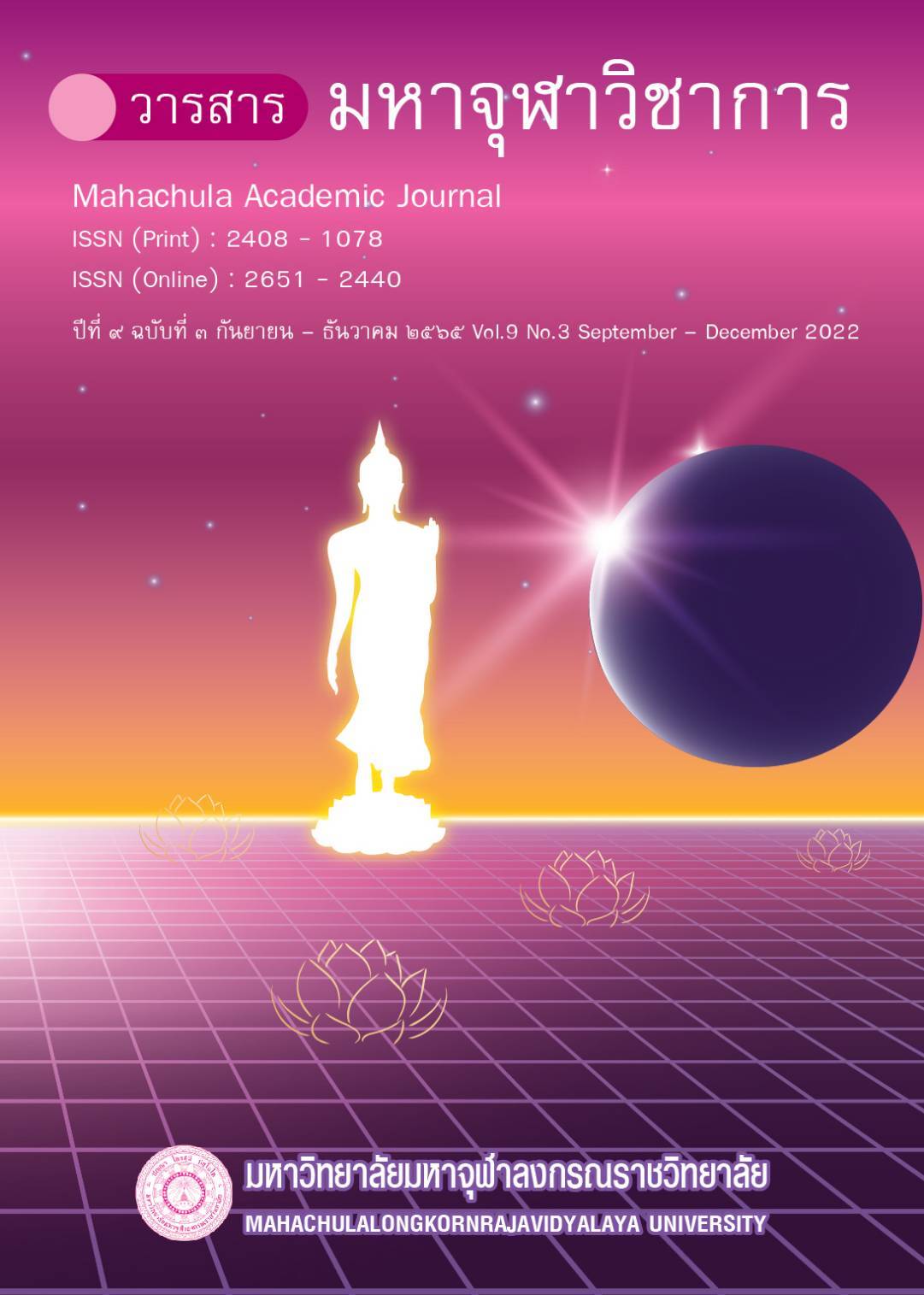Buddhist Tourism Management of Temples in Sri Prachan District Suphanburi Province
Main Article Content
Abstract
research subject “Buddhist Tourism Management of Temples in Si Prachan District Suphan Buri Province" has three objectives: (1) to study the level of people's opinion towards the Buddhist tourism management of temples in Si Prachan District; Suphan Buri Province (2) to compare people's opinions towards Buddhist tourism management of temples in Si Prachan District. Suphanburi Province Classified by personal factors (3) to propose guidelines for the management of Buddhist tourism of the temple in Si Prachan District Suphanburi Province In this research It is a mixed method research which consists of quantitative research. (Quantitative Research) from a population of 345 people and qualitative research. by in-depth interviews from key informants, 9 photos/person
The results of the research found that Applying the Sappurisdhamma Dharma principle to the management of Buddhist tourism of the temples in Si Prachan District Suphan Buri Province as a whole is at a high level. The mean was 4.05. When considering each aspect, it was found that the principle with the highest mean was the principle of parinyuta. at a high level The mean was 4.10. The main part with the lowest mean was the Mantanyuta principle. at a high level The mean was 4.01 Level of public opinion towards Buddhist tourism management of temples in Si Prachan District Suphan Buri Province found that the overall level was at a high level. with an average of 4.07. When considering each aspect, it was found that the aspect with the highest mean was the planning aspect. at a high level with an average of 4.10, while the aspect with the lowest mean was administrative at a high level has an average of 4.04 People's opinions towards Buddhist tourism management of temples in Si Prachan District. Suphanburi Province Classified by personal factors, it was found that sex, age, educational level, occupation, and income of the people as a whole were not different. therefore rejecting the hypothesis Guidelines for Buddhist Tourism Management of Temples in Si Prachan District Suphan Buri Province found that the planning To have a plan to work with other agencies. In terms of organizational arrangements, it was found that there should be a clear division of duties and responsibilities. As for personnel, it was found that officers should have the knowledge to give correct advice. As for the administration, it was found that there should be a coordinator to ensure that the operations were carried out smoothly throughout the work. In terms of supervision, it was found that the standards of Personnel standards should be established as an important basis for building personnel at tourist attractions General Suggestions (1) In terms of planning and measuring, there should be a network of organizations. to help with planning Develop temples and communities to be prosperous by creating participation from all parties in the community; Temples should be coordinated or assigned in requesting officers to provide advice according to the needs of the people. (3) Personnel, temples should train personnel inside the temple outside the temple. to be a public relations officer to give advice on what is knowledgeable to Buddhists; (4) organizational arrangements Personnel in the temple should have learning for management tasks. Buddhist tourism of the temple supports various activities of the temple. (5) Supervision, monks, temples, local administrative organizations, schools, and communities must cooperate in monitoring so that tourism can preserve the traditional way of life.
Article Details

This work is licensed under a Creative Commons Attribution-NonCommercial-NoDerivatives 4.0 International License.
References
เขตขันฑ์ คนงานดี. “การบริหารการพัฒนาวัดให้เป็นแหล่งท่องเที่ยวทางวัฒนธรรมในอําเภอเมืองสุพรรณบุรี จังหวัดสุพรรณบุรี. วารสารรัฐศาสตร์รอบรู้และสหวิทยาการ. ปีที่ ๓ ฉบับที่ ๒ (กรกฎาคม - ธันวาคม ๒๕๖๑) : ๑๙.
จุฑาภรณ์ หินซุย สถาพร มงคลศรีสวัสดิ. “แนวทางส่งเสริมการท่องเที่ยวเชิงพุทธ กรณีศึกษาวัดประชาคมวนาราม อำเภอศรีสมเด็จ จังหวัดร้อยเอ็ด”. วารสารวิชาการการท่องเที่ยวไทยนานาชาติ. ปีที่ ๑๐ ฉบับที่ ๑ (มิถุนายน ๒๕๕๗) : ๓๔๔.
ชวลิต ตั้งสมบูรณ์กิตติ. “การศึกษาการจัดการการท่องเที่ยวทางวัฒนธรรมภายในตลาดเก่าบ้านแหลม จังหวัดเพชรบุรี”. รายงานการวิจัย. สำนักงานการวิจัยแห่งชาติ (วช.) มหาวิทยาลัยศิลปากร, ๒๕๕๔.
ปรีดา ไชยา. “การท่องเที่ยวเชิงพุทธในจังหวัดสกลนคร ประเทศไทย”. วารสารสังคมศาสตร์วิชาการ. มหาวิทยาลัยราชภัฏเชียงราย. ปีที่ ๘ ฉบับพิเศษ (ตุลาคม - ธันวาคม ๒๕๕๘) : ๒๒๓.
พระปลัดกิจจา กิตฺติญาโณ. “การจัดการท่องเที่ยวเชิงพุทธของวัดพะโคะ ตำบลชุมพล อำเภอสทิงพระ จังหวัดสงขลา”. วารสารวิชาการ มจร บุรีรัมย์ Academic MCU Buriram Journal. ปีที่ ๑ ฉบับที่ ๒ (กรกฎาคม-ธันวาคม ๒๕๕๙) : ๔๐-๔๑.
พระมหาธัชธร สิริมงฺคโล (มาตรา). “การจัดการการท่องเที่ยวเชิงพุทธของวัดหนองแวง (พระอารามหลวง) อำเภอเมือง จังหวัดขอนแก่น”. พุทธศาสตรมหาบัณฑิต สาขาวิชารัฐประศาสนศาสตร์. มหาวิทยาลัยมหาจุฬาลงกรณราชวิทยาลัย, ๒๕๕๖.
พระสมุห์อนุรักษ์ ธีรสกฺโก. (ช้างเมือง). “การพัฒนาวัดเพื่อการทองเที่ยวเชิงพุทธในจังหวัดสมุทรสาคร”. วิทยานิพนธ์พุทธศาสตรมหาบัณฑิต สาขาวิชาการจัดการเชิงพุทธ. มหาวิทยาลัยมหาจุฬาลงกรณราชวิทยาลัย, ๒๕๕๔.
ภัชรบถ ฤทธิ์เต็ม. “รูปแบบการจัดการท่องเที่ยวเชิงศาสนาและวัฒนธรรมในวัด”. พุทธศาสตรมหาบัณฑิต พระพุทธศาสนา. มหาวิทยาลัยมหาจุฬาลงกรณราชวิทยาลัย. ๒๕๕๖.
วงศ์ระวิทย์ น้อมนำทรัพย์. “แผนยุทธศาสตร์เพื่อพัฒนาการท่องเที่ยวเชิงพุทธศาสนาอย่างยั่งยืนในจังหวัดนครปฐม”. ปรัชญาดุษฎีบัณฑิต สาขาการจัดการการท่องเที่ยว. มหาวิทยาลัยพะเยา, ๒๕๕๙.


